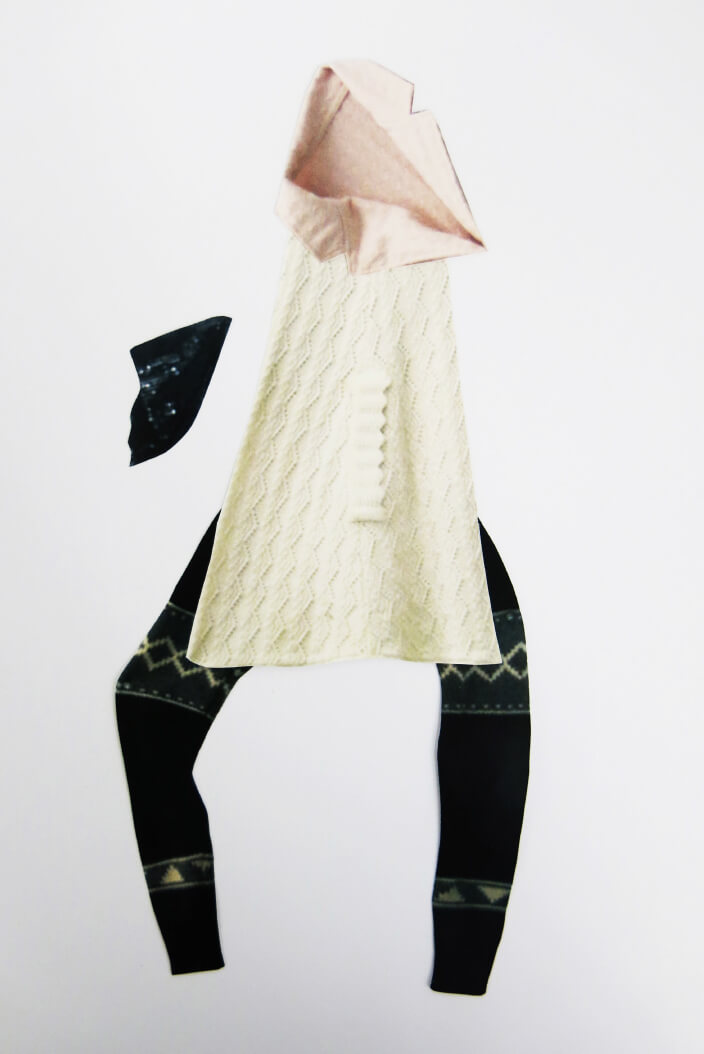“People need not only to obtain things, they need above all the freedom to make things among which they can live, to give shape to them according to their own tastes, and to put them to use.”
—Ivan Illich.
The New Clothes is a project that engages consumers in constructing new meaning, value, and potential from worn clothing. It is a framework for participation where physical maker-spaces and an online open-source platform collectively activate community dialogue. This joyful, social, creative approach to sustainability extends the lifespan of garments by evoking emotional connections, personal meaning, and authorship within a cultural context of mass-production.
Problem Space
Current globalized systems of manufacture have resulted in a disconnected consumer mindset. The need for a more intimate sense of material culture presents itself as a design opportunity. This project aims to reorient the user away from passive consumption towards open dialogue and active engagement.
Material Opportunity
Clothing is more than just a protective element: it is used to express who we are and what we value; a means to project our identity; a tool to navigate and communicate within the complexities of the external environment. Subtleties of human narrative and poetic expression are embedded within the clothing we wear. As a conceptual framework of embodied meaning, history, and personal value used clothing presents both material and emotional opportunity.

Abstraction Methodologies
Within the realm of used clothing there are many barriers to overcome, in particular the negative connotations surrounding old, used, and worn. As a means to break free from these limitations, various processes of material abstraction were explored.
Acts of hacking re-imagines used garments [3]. Systematic reworking of existing clothing optimizes material resources through new and unconventional uses. Transformation begins by considering the original garment and deconstructing it. Abstraction opens up each garment’s potential. Reconstruction creates new meaning and value through material transformation; layers of the making experience are embedded in the new.
A collage methodology can simultaneously critique and collectively build a more sustainable clothing culture. Collage is the act of combining separate parts to create new meaning. The design process is a form of bricolage [2] in which form and material, concepts, ideas, meaning, and language collide. We live in a mash-up paradigm; a collaged world, where culture is a continually remixed and re-contextualized. Collage is a creative, playful and reflective process that enables experimentation. In designing for the unexpected, collage is a means of bisociation: allowing abstract, unrelated ideas and concepts to combine to create new methods [1].
Photography is also key. It enables cultural browsing, and is a sketching tool that reveals new form, patterns, ideas and possibilities. Its capacity to facilitate 2-dimensional image-making and 3-dimensional material explorations has been integral to our generative research practice and The New Clothes framework.

System Touch-Points
Transforming used garments—embedding them with personal meaning, new value, and potential—requires active engagement from the original garment owners. The New Clothes maker-space is a replicable service-system with specifically designed touch-points. Participants begin by removing the garment labels and conducting a garment interview; this allows for reflection and decoding of personal, histories, and values embedded in the clothing. Next, as a warm-up for creative engagement, garments are traced on a wall. This sets the stage for the abstraction of known clothing into unfamiliar shapes. Previous clothing transformations provide context and inspiration for garment deconstruction. Tools, space, and support are available and expert sewers provide advice on the garment reconstruction process. Once sewn the participants stamp their new garments with The New Clothes brand specifying the time and date of re-creation.
Open-source patterns of the garment transformations are easily replicable and available through maker-space locations and the online platform. Designed for accessibility, little time or experience is required. Each transformation acts as an inspiration for additional alterations; a base to actively build and improve upon. This participatory design framework coincides with global movement towards collaborative maker-spaces where DIY initiatives are enhanced through community networks and shared resources: experiences, skills, and materials.
Conclusions
In its most practical sense, design is used to find solutions that are relevant and meaningful to people. In its most optimistic sense, design is a catalyst for social transformation; for communicating more positive futures. Confronted with increasingly complex, “wicked” problems, the designer’s role is shifting from that of expert to facilitator. Co-creating with others is key. Human resourcefulness, adaptability, and creativity are significant resources that when tapped can shift current assumptions and behaviour, offering new perspectives for a more desirable, sustainable material culture.
The New Clothes re-imagines used clothing garments through material transformation to extend the lifespan of existing garment resources by embedding personal meaning in the making experience. A model for systemic re-thinking—offering new perspectives on how material culture is devised, delivered, used, and reused—The New Clothes enables social innovation through community dialogue, collaborative effort, transparency and proximity of production and consumption.
This project is a collaboration between Mia Daniels and Ellen Russell. For more information visit www.thenewclothes.com.

References
- [1] Sanders, Elizabeth B. and Pieter Jan Stappers. Convivial Toolbox: Generative Research for the Front End of the Design. Amsterdam: BIS Publishers, 2012.
- [2] Turkle, Sherry. Evocative Objects: Things We Think With. Cambridge: MIT Press, 2007.
- [3] von Busch, Otto. Fashion-able: Hacktivisim and Engaged Fashion Design. University of Gothenburg: ArtMonitor Dissertation Series, 2008.
Industrial designer Mia Daniels loves to explore the industrial yards and back alleyways where the strange and curious found objects, reminiscent of a life once lived, provide inspiration for her creative process of unveiling object/material potential.
